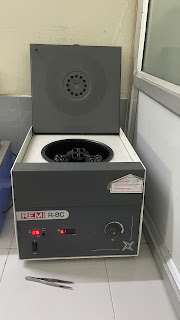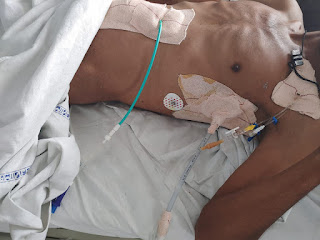MY INTERNSHIP EXPERIENCE & LEARNING JOURNEY
After entering into medicine posting; I had the NEPHROLOGY posting first
There I saw many patients joining into CKD ward ; but the bitter part is many of them don’t know that what ever the treatment may be & where ever they go they cant stop the ultimate death of patient who is entering into dialysis
This evoked my inner sense of empathy &laid down the path for me to take the detailed history for 2 patients who are newly entering to dialysis because of Chronic Kidney Disease ( CKD )
The details of the blog links are below :
I have assisted Dr.Chandana mam ( pgy3 ) in central line
Coming to ICU DUTIES ; I’ve had my ups and downs, even then they are most memorable internship duties till date.
Because ; before ICU I didn’t do any procedure except for the 3 stictches in the surgical OT & regular ulcer dressings, this place gave me so much opportunity to learn ABG, RYLES TUBE, FOLEYS CATHETER , taking SAMPLES. I’ve taken approximately 25 ABG Till date and no doubt its because of icu duties ive learnt the technique.
Did ascitic tap for a patient in Z TARCK TECHNIQUE under the guidance of Dr.Haripriya mam ( pgy2 )
MY EXPERIENCE OF ONE HECTIC ICU NIGHT DUTY:
On the second ICU bed there is an intubated patient with zero percent survival chance ; she had no peripheral pulses and her bp was not recordable from 10 pm. I’ve checked her carotid pulse every 15-20 mins :/ may be just to give their attenders correct death time , at around 6 in the morning even carotid pulse was lost and then we started CPR ; for about 30 mins ; she regained the carotid pulse which was slow, irregular and prominent ( it mostly may be because of the drugs we gave her )& ECG was done and it didn’t show flat line ; it showed some strange pattern —after15 mins her pulse became fast, regular but less prominent — after 15 mins again her carotid pulse was lost — CPR was done again for 30 mins , but couldn’t revive the patient this time — ECG was done and it showed a flat line — patient was declared dead at around 7:40 am
On the third bed there is ‘imaginary pillow case; who got intubated and extubated’ on that day itself he was shifted to ICU from AMC for his SOB ; he wasn’t keeping on the oxygen mask and not listening to my words( his sats are dropping to 80 without oxygen mask) ;his wife is least bothered about all this & slept
On the fourth bed there is case of Diabetic Ketoacidosis; for which I’ve given a chart to adjust the insulin infusion rate accordingly to hrly grbs ; the grbs values are persistently high during consecutive hrs in the night; but the point I didn’t observe is the NS fluid correction is not going well for the other hand as there is a block ; after noticing that I gave flush 1-2 times and by the late morning his sugar values came down
COMING TO THE STRANGE PART; WHEN I’VE ENTERED ICU CPR AND INTUBATION WAS DONE FOR ONE CASE AND BY THE TIME I’VE LEFT ICU THERE IS A DEATH OF ANOTHER INTUBATED CASE ; for my 1st icu duty when I entered at 8am ;there was a case in AMC - for which bp was not recordable — immediately the case is shifted to ICU and CPR was done; for this patient there was a central line procedure done by Dr. Narsimha sir ( pgy2 ) for which I’ve did the simple 2-2-1 suturing ;however, this patient died after 2 and 1/2 days ; the other 2 1/2 days of my 5 days icu posting is shared by the patient which was described above ( icu bed 2 ) and by the time I’ve completed my 5 days icu journey; she died
During my duties; in the free time Dr. DK sir(pgy3) explained me ECG & other concepts & Dr. Raveen sir ( pgy3) , Dr. Sai Charan sir ( pgy3 ) have explained some interesting concepts around the current admitted patients
I think in the ICU we need to become cold hearted , dumb, bold to do the duties ; every minute in there is challenging, it’s tougher than you think; you will become braver, stronger and smarter if you utilise your time wisely in ICU
HOW ARE PT, INR TESTS DONE IN OUR LAB :
First blood of the patient is collected in blue coloured vacutainer ( containing an anticoagulant- 3.2% sodium citrate) and then blood is centrifuged for 15 mins thereby separating the plasma from the cells
MACHINE USED FOR CENTRIFUGE
SERUM SEPERATED FROM CELLS AFTER CENTRIFUGING
This plasma ( a quantity of 200 micro litres ) is taken into a tube and a quantity of 200 micro litres of reagent ( UNIPLASTIN - contains liquid rabbit brain thromboplastin ) is taken into an other tube ; now both tubes are kept in water bath ( of temp 37 degree celsius )— wait for 3 mins
REAGENT : UNIPLASTIN
WATER BATH
After 3 mins ; take both tubes out of water bath and then start a timer & add patient’s plasma to reagent ; the time by which clot formed is noted and is determined as PT ( the time in seconds is counted manually )
The normal range of PT is 10-16 seconds
Coming to INR ; it is calculated by dividing patient’s PT with control PT ie., INR = PATIENT’S PT / CONTROL PT
Control PT is standard value ( constant ) which is 13.5 seconds
The normal range of INR is less than 1 , any value higher than 1 is considered as significant derangement; but jn patient’s using warfarin ; INR of a range of 2-3 is considered normal
HOW TO GRADE THE PROSTATOMEGALY :
( USG procedure being done at our college is TAS for prostate volume estimation)
First the length and width are noted & then changing the direction of probe we can get the height ( parameters are measured in cms )
Volume of prostate = length x width x height x 0.5
GRADING : ( of Prostatomegaly ) on the basis of measured volume -
1) NORMAL = 25 cc
2) GRADE 1 = 25 to 50 cc
3) GRADE 2 = 50 to 75 cc
4) GRADE 3 = > than 75 cc
In the above picture , there are 2 images (of prostate) ; In the 1st image to left - the length and width are noted & in the 2nd one to right ( it is obtained by changing the probe direction ) - the height is noted
HOW TO GRAGE FATTY LIVER BASED ON USG FINDINGS :
The normal USG of liver is ; hepatocytes are hypoechoic and there is well marked peri portal hyperechogenicity
& diaphragmatic hyperechogenisity
Grading of fatty liver :
grade I: diffusely increased hepatic echogenicity but periportal and diaphragmatic echogenicity is still appreciable
grade II: diffusely increased hepatic echogenicity obscuring periportal echogenicity but diaphragmatic echogenicity is still appreciable
grade III: diffusely increased hepatic echogenicity obscuring periportal as well as diaphragmatic echogenicity
Refer this article for clinical images :
I have done a blog of a 62 yr old man who presented with type 1 respiratory failure with cardiogenic pulmonary edema who is k/c/o DM,HTN & CKD and DR. Shailesh ( pgy3 ) presented my case during an integrated meet ; link to my blog & details to presentation are as follows:
BLOG LINK : https://63konakanchihyndavi.blogspot.com/2023/01/this-is-online-e-log-book-to-discuss_7.html
4) DR SHAILESH PRESENTATION ON CASE OF COMPLEX DIABETES :
QUESTIONS ASKED : (during the CME)
1) How do you diagnose cardiogenic pulmonary edema?
2) What is the treatment difference in cardiogenic pulmonary edema and non cardiogenic pulmonary edema?
3) How much duration will it take to cause macroangiopathy?
4) How will Diabetes cause heart failure?
AROUND THE SAME PT I HAVE PREPARED A CME PRESENTATION ; details are below in the blog link :
The other case report links of which I’ve did blogs during posting period:
Follow up case of SLE of Dr. Vinay sir ( pgy3 ); the case was explained to me in detail by Dr.Vinay sir ( pgy3 ) , blog link is below:







Comments
Post a Comment